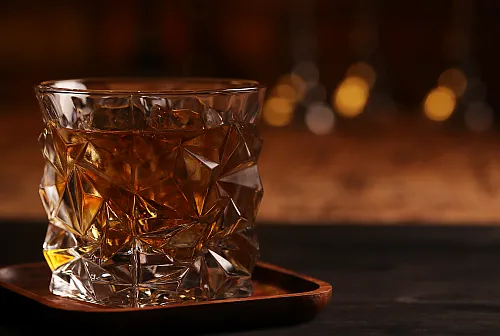Whiskey: A World of Rich Flavors and Traditions
Whiskey, or whisky, is a spirit steeped in tradition and diversity, made from fermented grain mash. Its identity is deeply tied to its region of production and the grains used, leading to a vast spectrum of flavors and styles. From the smoky peat of Scotch to the sweet smoothness of Bourbon, whiskey offers a complex world for connoisseurs and casual drinkers alike.
Exploring the Types of Whiskey
- Straight Whiskey: Predominantly an American style, made from at least 51% of a single grain type and aged in new charred oak barrels for at least two years, offering a pure expression of the grain’s character.
- Bourbon: An iconic American whiskey, Bourbon is made from a mash containing at least 51% corn, aged in new charred oak barrels. While synonymous with Kentucky, it can be produced anywhere in the U.S.
- Rye Whiskey: Similar to Bourbon but distilled from at least 51% rye, this American whiskey is known for its drier and spicier profile, offering a bolder taste.
- Tennessee Whiskey: A subset of straight whiskey, it’s distinguished by its filtration through maple charcoal before aging, a process known as the Lincoln County Process, lending it a unique smoothness.
- Irish Whiskey: Renowned for its smooth and approachable character, Irish Whiskey is aged in wooden barrels for at least three years, often featuring a blend of malted and unmalted grains.
- Scotch Whisky: Known for its smoky notes and robust flavors, Scotch is made from malted barley, aged in oak barrels for at least three years, with many varieties using peat smoke during the drying process.
- Canadian Whisky: Typically known for its smoothness, Canadian Whisky often involves blending separately fermented, distilled, and aged grains.
- Japanese Whisky: Influenced by Scotch, Japanese Whisky has gained international acclaim for its quality and complexity, often featuring extended barrel aging in various cask types.
Understanding Whiskey Labels
- Single Malts: Produced by a single distillery using only malted grain, typically barley, offering a distinct taste of a particular distillery’s style.
- Blended Malts: A mix of single malts from different distilleries blended to achieve a harmonious flavor profile.
- Blended Whiskies: Combining malt and grain whiskies, these blends are crafted for balance and consistency.
- Single Cask/Barrel: Each bottle comes from an individual barrel, offering a unique and unrepeatable flavor.
- Cask-Finished: Whiskies that undergo secondary aging in a different type of barrel acquire additional flavor layers.
- Overproof: Whiskies with an ABV higher than the standard 40% offering a more intense flavor and strength.
- Bonded: A legal designation in the U.S. that guarantees the whiskey’s production by one distiller at one distillery in one season, aged for at least four years, and bottled at 100 proof.
The Most Known Cocktails, Including Whiskey
BOURBON: Manhattan, Eli Cash, Old-Fashioned, Parlour Old-Fashioned, Rock ’n’ Rolla, Evergreen Terrace, Mint Julep, Charleston Sour, Shark Eye, and Bourbon Chai Milk Punch.
SCOTCH: Rob Roy, Rusty Nail, The Adventures of Pete & Peach, Bitter Scotsman, Blood & Sand, Kilt & Jacket, Shorter, Faster, Louder, and 443 Special.
WHISKEY: Sazerac, Irish Coffee, In Cold Blood, Jack & Juice, The Circle of the Sun, The Way of the Sword, Matcha Highball, and Double-Barrel Fizz.
Did you know about the Whiskey?
- Ancient Techniques, Modern Spirit: The art of distilling whiskey can be traced back to ancient Mesopotamia, around 2000 BC. However, it was initially used for perfumes and later adapted for whiskey production in Scotland and Ireland.
- The “Water of Life”: The word whiskey comes from the Gaelic phrase “uisce beatha,” which translates to “water of life.” This term underscores whiskey’s importance in early Scottish and Irish culture.
- A Presidential Distiller: George Washington, the first President of the United States, operated one of the largest whiskey distilleries in America at his Mount Vernon estate after his presidency.
- The Angel’s Share: A portion of whiskey evaporates from the barrel during aging. This is whimsically called the “Angel’s Share,” a natural part of the aging process that contributes to the whiskey’s final flavor.
- Scotland’s Wealth of Distilleries: Scotland is home to more than 130 malt and grain distilleries, making it the world’s greatest concentration of whiskey production. Each region in Scotland produces a whiskey with a distinct flavor profile.
- Irish Whiskey’s Triple Distillation: Unlike most Scotch whiskies, which are typically distilled twice, Irish whiskey is often distilled three times, resulting in a smoother and lighter spirit.
- The Birth of Bourbon: Bourbon, a type of American whiskey, was named from Bourbon County, Kentucky, where local distillers developed the distinct corn-based whiskey in the 18th century.
- Japanese Whiskey’s Rise: Japanese whiskey has recently gained popularity and international acclaim. It closely resembles Scotch in style and method but often features unique Japanese characteristics.
- The World’s Oldest Whiskey: The Old Bushmills Distillery in Northern Ireland is considered the oldest licensed whiskey distillery in the world, with its license dating back to 1608.
- Whiskey Rebellion: In the 1790s, the newly formed United States experienced the Whiskey Rebellion, where whiskey producers in Pennsylvania rebelled against a federal tax on whiskey, showcasing the spirit’s economic and cultural significance.
Whiskey’s rich tapestry of styles and flavors is a testament to its global appeal and the depth of its craft. Whether sipped neat, on the rocks, or as part of a sophisticated cocktail, whiskey is a spirit that tells a story of its origin, ingredients, and the skill of its makers.

